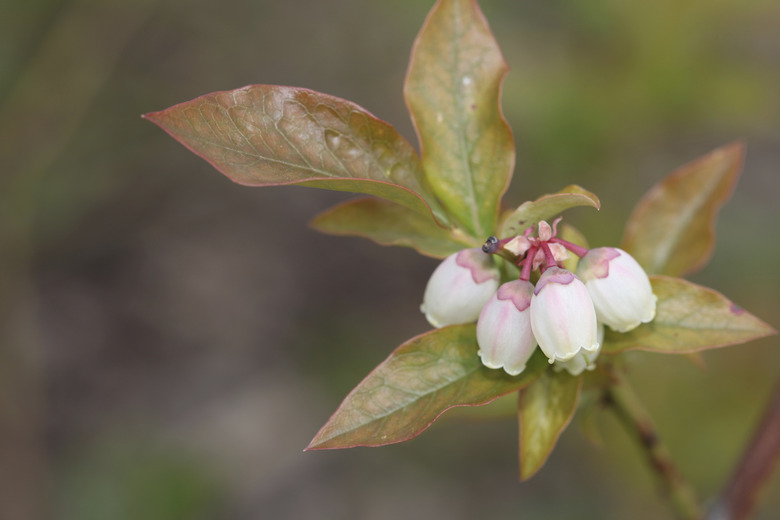Plants That Resemble Blueberries
Blueberries (Vaccinium spp.), one of the tastiest summertime treats in gardens or in fields, grow blue to dark blue berries. Different species thrive in the wild, and a multitude of hybrids and cultivars are available to grow in the garden. Blueberry bushes have oval, smooth-edged leaves with pointed tips. Other plants that closely resemble blueberries are relatives of blueberries and also in the heath family, such as huckleberry (Gaylussacia spp.), salal (Gaultheria shallon) and bilberry (Vaccinium myrtillus). Some unrelated plants may have similar round, purplish to black berries that may not be safe to eat. Don't eat fruit from a plant unless you're certain of its identity.
- Blueberries (Vaccinium spp.
- ), Other plants that closely resemble blueberries are relatives of blueberries and also in the heath family, such as huckleberry (Gaylussacia spp.
- ),
Blueberry Characteristics
Blueberry fruits usually have a whitish, powdery coating and numerous tiny seeds. The blue color can vary from pale to deep purplish blue. Berries grow singly or in clusters on woody, deciduous bushes that go from very low to tall. Highbush blueberry (Vaccinium corymbosum), hardy in U.S. Department of Agriculture plant hardiness zones 3 through 8, is 6 feet tall and wide. Lowbush blueberry (Vaccinium angustifolium, USDA zones 3 through 6) is only 8 to 18 inches tall. Rabbit-eye blueberry (Vaccinium ashei, USDA zones 7 through 9), native to the Southern United States, reaches 10 feet high.
Huckleberry Bushes
Huckleberries (Gaylussacia spp.) generally have smaller, shinier and darker-colored fruits than blueberries. However, instead of small seeds like those of the blueberry, huckleberry fruits have 10 large, hard seeds. Blue huckleberry (Gaylussacia frondosa, USDA zones 7 through 9) is about 3 feet tall and has blue fruits with a white powder coating very similar to that of blueberries. With blue to black berries, black huckleberry (Gaylussacia baccata, USDA zones 5 through 9) reaches 1 to 3 feet tall. Huckleberry leaves have golden yellow glands on the leaf undersides, which blueberries lack. The glands are visible through a magnifying lens.
- Blueberry fruits usually have a whitish, powdery coating and numerous tiny seeds.
- However, instead of small seeds like those of the blueberry, huckleberry fruits have 10 large, hard seeds.
- Blue huckleberry (Gaylussacia frondosa, USDA zones 7 through 9) is about 3 feet tall and has blue fruits with a white powder coating very similar to that of blueberries.
Salal Bushes
Native to coastal California and the Pacific Northwest, salal (Gaultheria shallon), hardy in USDA zones 7 through 10, grows well in woodland gardens. Plants are 3 to 4 feet tall, but up to 10 feet tall in shaded areas. **The bluish fruits don't have much flavor.** The leaves are larger than blueberry leaves, and glossy. There are other gaultheria varieties, some of which are ground covers.
Bilberry Plants
A small-growing blueberry relative, bilberry (Vaccinium myrtillus, USDA zones 3 through 7) bushes are low and spreading. They're useful as ground covers and have pea-sized dark blue to blackish edible berries. Berries are dried, eaten fresh and used in preserves.
- Native to coastal California and the Pacific Northwest, salal (Gaultheria shallon), hardy in USDA zones 7 through 10, grows well in woodland gardens.
- A small-growing blueberry relative, bilberry (Vaccinium myrtillus, USDA zones 3 through 7) bushes are low and spreading.
- They're useful as ground covers and have pea-sized dark blue to blackish edible berries.
- Berries are dried, eaten fresh and used in preserves.
Pokeberry Fruits
Pokeberry (Phytolacca americana) plants don't resemble blueberry bushes, because they're fast-growing, non-woody perennial plants. They reach 6 feet tall and 5 feet wide, and have large, soft leaves and red stems. The deep purple-black, glistening berries appear in late summer to early fall in an elongated cluster somewhat resembling grapes. Fruits are toxic and all plant parts are poisonous. The leaves can cause skin irritation. Pokeberry fruits are easy to differentiate from blueberries by the lack of whitish powder, the fruit arrangement, and the late ripening period.
Black Nightshade
A common, weedy plant you can find in disturbed areas almost everywhere, black nightshade (Solanum nigrum, Solanum ptycanthum) is hardy in USDA zones 4 through 7 and can be an annual elsewhere. It's a perennial rather than a shrub. The rounded fruits are first green, then turn purple-black to black, and grow in small clusters that dangle from the stems. Fruits are smaller than blueberries and don't have the whitish bloom. They can be toxic.
- Pokeberry (Phytolacca americana) plants don't resemble blueberry bushes, because they're fast-growing, non-woody perennial plants.
- They reach 6 feet tall and 5 feet wide, and have large, soft leaves and red stems.
Buckthorn Bushes
Common buckthorn (Rhamnus cathartica, USDA zones 3 through 7) is a native of Europe that is now naturalized and invasive in North America. The large shrub grows 6 to 20 feet tall, and branches end in sharp spines. Berries are glistening, purplish-black to black, appearing in fall. Although there are unpleasant purgative effects if the fruit is eaten, they're not seriously toxic.
References
- U.S. Department of Agriculture: Classification: Vaccinium
- Plants for a Future: Vaccinium Corymbosum – L.
- National Gardening Association: Blueberry Prescription
- Floridata: Gaylussacia Frondosa
- Plants for a Future: Gaylussacia Baccata
- Pacific Horticulture: Gaultheria
- Plants for a Future: Vaccinium Myrtillus
- University of Vermont Extension: Home Fruit Growing–Less Common Fruits
- Plants for a Future: Phytolacca Americana – L.
- Michigan State University: Solanum Ptychanthum
